
Classy hotels a key to local commerce
5/27/2012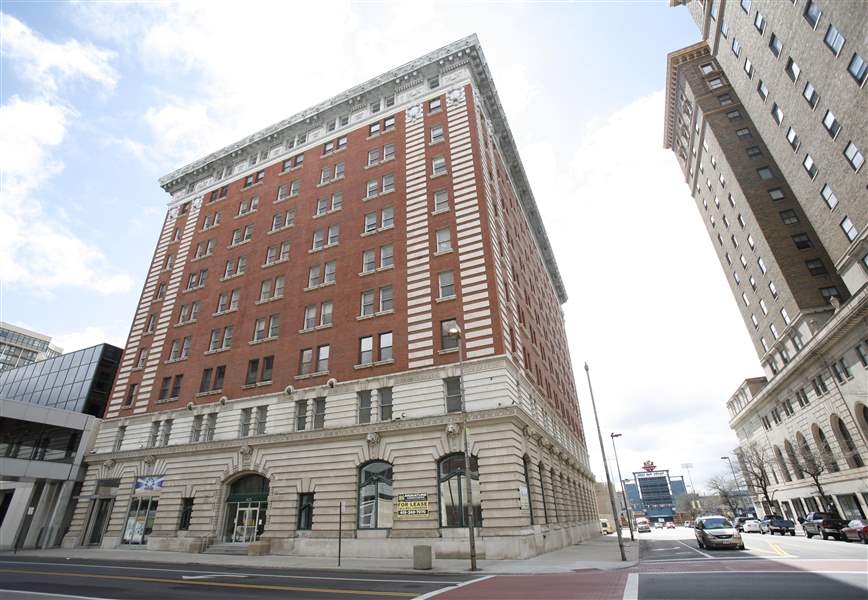
The building that housed the former Secor Hotel sits at the corner of Jefferson and Superior streets. To the right is the Commodore Perry, now an apartment building.
The Blade
Buy This Image
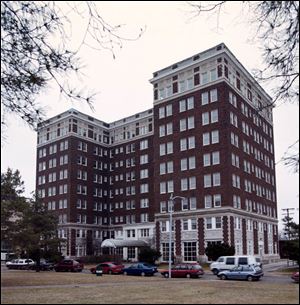
Built in 1927, the Park Lane was once among the 'grand old hotels' that dotted the downtown Toledo area. The Park Lane, like some of the others, has been converted into apartments.the blade
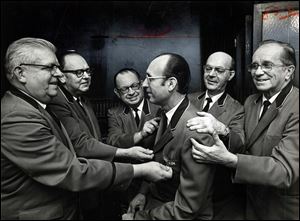
Commodore Perry Motor Inn bellmen take a break to compare their length of service. From left in the 1972 image are Frank Kitz, Ed Kaminski, Herman Lund, Byron Myler, Henry Zarick, and Walt Trost. Bellmen have become a rare sight at Toledo hotels.
Elegant and upscale hotels dotted downtown Toledo on and off from the turn of the last century through much of the city's prosperous years before the Rust Belt tightened like a noose around the neck of the region.
Some of those buildings -- such as the former Waldorf Hotel along the Maumee River -- are now rubble buried deep in a landfill after years of empty rooms ran it out of business. Others, such as the former Secor Hotel on Jefferson Avenue at Superior Street, are either vacant or partially rented out to tenants that include a charter school. Others have been converted into upscale or low-income apartments -- including the Commodore Perry, the Hillcrest, and the Park Lane.
At one time, the city was 10,000 hotel rooms strong in the downtown area with healthy vacancy rates, a far cry from the number of available and filled hotel spaces now.
Doug DeGood, who was Toledo's mayor from 1977 to 1983, recalls some of the last days of fancy hotels with brunches that drew Toledoans downtown and impeccable white-glove service that catered to visiting businessmen. He said quality hotels were an important part of what Toledo needed to attract businesses and their upscale out-of-town clients.
Toledo, he said, could support a higher-end hotel by the time he moved away from the city in 1999, in part because the SeaGate Convention Centre was attracting better conventions than those that rented out the former Sports Arena on the east side.
"I think that, yes, higher-end hotels attract a clientele who in many cases won't go to a place with a hotel a peg or two lower," Mr. DeGood said. "It is beneficial to have a hotel perceived as top of the pile."
RELATED CONTENT:
- Hotels in Toledo fall far short of elite status
- Range of factors determine star power of hotels
- Click to view "How Hotels Compare"
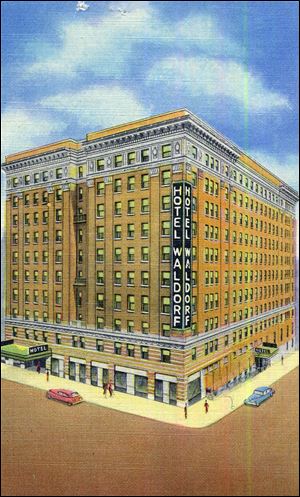
A postcard depicts the Waldorf Hotel at Summit Street and Madison Avenue.
The Sofitel Hotel, which is now the Grand Plaza Hotel, opened on the banks of the Maumee downtown in September, 1985, at a construction cost of nearly $30 million. It was run by a French hotel conglomerate that at the time was one of the largest in the world.
It was the city's only luxury hotel when it opened and helped erase the city's shameful reputation as a terrible place to stay. Two years after its grand opening, it had lost more than $4.61 million, and it was out of business by 1988.
Since then, the hotel has changed owners and names numerous times. It became the Marriott Portside in 1988, then was bought by Gencom American Hospitality Inc. in 1994 and became the Holiday Inn Crowne Plaza and, later, just the Crowne Plaza. In 1998, the hotel became the Wyndham when it was bought by Wyndham International Inc., which sold the property in 2005 to Toledo Hotel Investors, a private-equity group. When Paradise Hospitality of Fullerton, Calif., bought it in 2007, it changed the name to the Toledo Riverfront Hotel until it regained the Crowne Plaza affiliation in June, 2008.
"There were three grand old hotels, the Commodore Perry, the Secor, and the Park Lane, and that would have been on the west end of downtown," Mr. DeGood said. "They were grand old elegant places, and the Sofitel Hotel downtown was very modern and it was a first-rate hotel. I don't know what the problem with the Sofitel was, but I suspect they had a price structure that probably didn't work in that market."
The oldest standing structure downtown started out as a hotel. The Oliver House, at 27 Broadway, built nearly 153 years ago, is now home to a brewery, four bars, three restaurants, a small theater, and 15 residential apartments, said Neal Kovacik, general manager.
A news report from February, 1929, said the primary purpose of the building was to draw business to the city.
"When the hotel opened, it was one of the fanciest in the eastern part of the United States," Mr. Kovacik said. "It had 171 rooms, with running water, gas lights, and a fireplace in every room.
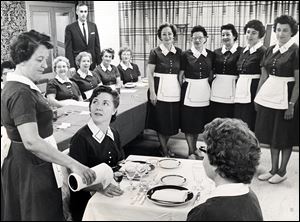
A training session for waitresses is provided to employees at the Commodore Perry in 1962. The Commodore Perry was considered one of the top downtown hotels.
When Toledo was still a new city, many hotels were built within a two-block radius of Summit Street and Jefferson Avenue downtown. Over the past 140 years, at least 15 hotels carried a Summit Street address and even more were on Jefferson.
The Boody House, built in either 1872 or 1873 (depending on the source), was quickly popular and became known for being Toledo's most commodious and comfortable. At least six sitting or former presidents visited or stayed at the location. It was razed in 1929.
At the time, the Toledo Council of Churches paid it tribute with a religious service.
Also during that period came the Waldorf, built by George Waldorf at Summit and Madison in 1917.
The Fort Meigs Hotel was built by Sam Davis in 1927 and was razed in 1966; the Park Lane and the Commodore Perry also were built in 1927, and the Hillcrest was erected two years later in 1929.
The Commodore Perry Hotel closed in 1980.
Some hotels followed the upswing of prosperity in the 1920s but then were damaged financially by the Great Depression that followed.
Downtown hotels reached a peak occupancy after World War II -- almost 90 percent -- but then slipped to 55 percent by 1962.

The building that housed the former Secor Hotel sits at the corner of Jefferson and Superior streets. To the right is the Commodore Perry, now an apartment building.
That was attributed to the proliferation of motels along the nation's highways, where people would stay before hitting the downtowns.
Jerry Chabler, a member of the Toledo-Lucas County Port Authority, said the quality of historic hotels a century ago, and more recently, reflected the business needs of the city at those times.
"The Commodore Perry, the Secor, the Hillcrest -- those were great facilities, historically and servicewise," Mr. Chabler said.
He said the current stock of hotels downtown doesn't compare.
"I think there is room for improvement and … from an aesthetic viewpoint, some of the hotels downtown leave a lot to be desired," Mr. Chabler said.
"It is very important, especially for business folks -- no question about it -- that we have good hotels. I think the casino may motivate some of these facilities to either upgrade or motivate some larger hotels to locate here in Toledo."
He too recalled the Sofitel well as "a great hotel" and lamented its sale.
Its demise mirrored the downturn of some of Toledo's biggest employers during that period.
The city had as many as seven Fortune 500 companies within its borders and as many as three others were in the region.
Among them were Owens Corning, Owens-Illinois Inc., and Dana Corp., which is now Dana Holding Corp.
At one time, Toledo plants produced three of the world's best-known products: Jeep, Toledo Scales, and Champion spark plugs. Only Jeep remains.
When the Sofitel was new, local big companies that developers had expected to buy lots of rooms were in trouble.
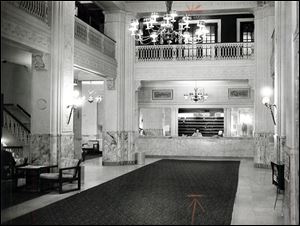
A clerk works at the desk in the empty lobby of the Waldorf Hotel in November, 1977.
Former Toledo Mayor Donna Owens was on city council when plans for the Sofitel were being laid out.
"It was a fine upscale hotel, but I didn't think the community would support it, but at the time we had a lot of CEOs who wanted something upper scale for their clients downtown to go to, so it worked for a while," Ms. Owens said.
"But the economy had a downturn and some the companies like O-I didn't have the clientele to support it."
In 1986, Owens Corning rejected a $74-a-share buyout offer from Wickes Co., a lumber and building materials conglomerate based in Santa Monica, Calif.
The rejection of the unsolicited takeover attempt forced the company to launch a comprehensive restructuring plan that meant assuming $2 billion in debt and slashing its work force by 43 percent worldwide.
Wickes made a $30 million profit by selling back all of the Owens Corning shares it purchased during the takeover attempt.
Owens-Illinois was taken over in a leveraged buyout by Kohlberg Kravis Roberts & Co. in 1987, and many of its operations were sold, in part to pay the staggering debt it incurred.
Also in the Fortune 500 category, in the 1980s, northwest Ohio lost the headquarters for Marathon Oil Co., Questor Corp., Sheller-Globe Corp., Champion Spark Plug Co., and Libbey-Owens-Ford Co. because of takeovers.
Matt Schroder, spokesman for Owens Corning, Toledo's only remaining Fortune 500 company, said the firm uses a variety of hotels for guests.
"We use the Grand Plaza, Park Inn, Hilton Garden Inn, Hilton at MUO [now University of Toledo Medical Center, formerly Medical University and Medical College of Ohio]," Mr. Schroder said.
The Park Inn was opened as a relatively upscale Radisson 25 years ago but soon found itself in financial trouble. In 2006 it became a Park Inn, which is billed as the mid-scale brand of Carlson Hotels, the company that also owns Radisson hotels. Built for $42 million in 1987, it sold last fall to a group of unidentified Chinese investors for $3 million.
Chuck Hartlage, spokesman for Dana, said the company puts people at one hotel in Toledo and several in Perrysburg, Holland, Maumee, and Sylvania, but he wouldn't name the hotels.
Debbie Crow, a spokesman for The Andersons Inc., said its corporate guests stay at the Residence Inn, Holiday Inn, the Hilton Toledo, or Marriott Courtyard in Maumee.
"We have strong relationships with four," she said. "They meet our quality standards and we have a negotiated price with them."
Blade Food Editor Dan Neman contributed to this report.
Contact Ignazio Messina at: imessina@theblade.com or 419-724-6171.